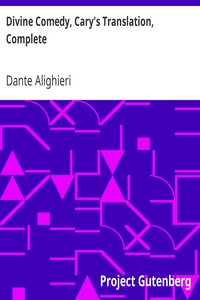Divine Comedy, Cary's Translation, Complete by Dante Alighieri
"The Divine Comedy" by Dante Alighieri is an epic poem written in the 14th century. This monumental work is divided into three parts: Inferno (Hell), Purgatorio (Purgatory), and Paradiso (Paradise), each exploring the themes of life after death, divine justice, and the human soul's journey toward God. The narrative primarily follows Dante, the protagonist, as he travels through these realms, guided first by the Roman poet Virgil and later by Beatrice, who
represents divine love. The opening of the poem sets the stage for Dante's journey: it begins with a vivid depiction of Dante's despair as he wanders through a dark forest, symbolizing confusion and sin. Struggling between paths, he encounters various allegorical beasts that represent different sins and obstacles. Ultimately, he meets Virgil, who offers to guide him through Hell—a place filled with the tormented souls of the damned, each suffering for their earthly sins. This initial segment introduces readers to the themes of redemption and moral choice as Dante lays the groundwork for his exploration of the afterlife, setting the tone for an odyssey filled with rich symbolism, philosophical inquiry, and social commentary. (This is an automatically generated summary.)
Read or download for free
| How to read | Url | Size | |||
|---|---|---|---|---|---|
| Read now! | https://www.gutenberg.org/ebooks/1008.html.images | 988 kB | |||
| EPUB3 (E-readers incl. Send-to-Kindle) | https://www.gutenberg.org/ebooks/1008.epub3.images | 569 kB | |||
| EPUB (older E-readers) | https://www.gutenberg.org/ebooks/1008.epub.images | 574 kB | |||
| EPUB (no images, older E-readers) | https://www.gutenberg.org/ebooks/1008.epub.noimages | 560 kB | |||
| Kindle | https://www.gutenberg.org/ebooks/1008.kf8.images | 924 kB | |||
| older Kindles | https://www.gutenberg.org/ebooks/1008.kindle.images | 814 kB | |||
| Plain Text UTF-8 | https://www.gutenberg.org/ebooks/1008.txt.utf-8 | 891 kB | |||
| Download HTML (zip) | https://www.gutenberg.org/cache/epub/1008/pg1008-h.zip | 459 kB | |||
| There may be more files related to this item. | |||||
Similar Books
About this eBook
| Author | Dante Alighieri, 1265-1321 |
|---|---|
| Translator | Cary, Henry Francis, 1772-1844 |
| Title | Divine Comedy, Cary's Translation, Complete |
| Note | See also PG#1004 tr. by H. W. Longfellow |
| Note | Wikipedia page about this book: https://en.wikipedia.org/wiki/List_of_English_translations_of_the_Divine_Comedy |
| Credits | Judith Smith and Natalie Salter |
| Reading Level | Reading ease score: 75.4 (7th grade). Fairly easy to read. |
| Language | English |
| LoC Class | PQ: Language and Literatures: Romance literatures: French, Italian, Spanish, Portuguese |
| Subject | Epic poetry, Italian -- Translations into English |
| Subject | Italian poetry -- To 1400 -- Translations into English |
| Category | Text |
| EBook-No. | 1008 |
| Release Date | Aug 1, 1997 |
| Most Recently Updated | Jul 4, 2022 |
| Copyright Status | Public domain in the USA. |
| Downloads | 647 downloads in the last 30 days. |
| Project Gutenberg eBooks are always free! | |

